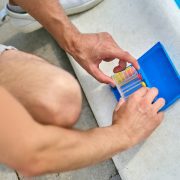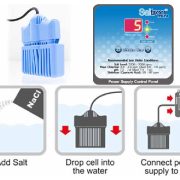
Mastering Pool Alkalinity: How to Test, Raise, and Lower Levels for Optimal Swimming Conditions
Learn how to test, raise, and lower your swimming pool’s alkalinity to maintain the ideal water chemistry for a safe, comfortable, and enjoyable swimming experience.
Introduction
Maintaining proper alkalinity levels in your swimming pool is essential for ensuring a balanced, healthy, and comfortable swimming environment. Alkalinity acts as a buffer to prevent rapid pH fluctuations, which can cause damage to pool equipment, irritate swimmers’ skin and eyes, and reduce the effectiveness of sanitizing chemicals. In this article, we will guide you through the process of testing, raising, and lowering your pool’s alkalinity levels to maintain optimal water chemistry.
Testing Pool Alkalinity
Regular testing is crucial to monitoring your pool’s alkalinity levels and making necessary adjustments. Alkalinity levels should be maintained between 80 and 120 parts per million (ppm) for most pools, although some pool manufacturers may have slightly different recommendations.
- Choose a testing method: To test your pool’s alkalinity, you can use either a liquid test kit or test strips. Both methods are readily available at pool supply stores and online.
- Collect a water sample: Using a clean container or the provided vial, collect a water sample from at least 12 inches below the surface and away from return jets.
- Follow the testing instructions: Carefully follow the instructions provided with your chosen test kit or test strips. This will typically involve adding a specific number of drops of testing solution to the water sample or dipping a test strip into the sample for a specified time.
- Read the results: Compare the color of the water sample or test strip to the provided color chart to determine your pool’s current alkalinity level.
Raising Pool Alkalinity
If your pool’s alkalinity level is below the recommended range, you will need to raise it using an alkalinity increaser, typically a sodium bicarbonate-based product.
- Determine the required amount: Refer to the instructions on your chosen alkalinity increaser to calculate the amount needed based on your pool’s current alkalinity level and volume.
- Pre-dissolve the product: To avoid cloudiness and promote even distribution, dissolve the alkalinity increaser in a bucket of warm water before adding it to the pool.
- Add the increaser: Slowly pour the dissolved alkalinity increaser into the pool, distributing it evenly around the perimeter.
- Circulate the water: Run your pool’s circulation system for at least 4 hours to ensure thorough mixing and distribution.
- Re-test and adjust: Wait 24 hours before re-testing your pool’s alkalinity level and making any further adjustments as necessary.
Lowering Pool Alkalinity
If your pool’s alkalinity level is too high, you can lower it using a pH reducer or muriatic acid.
- Determine the required amount: Follow the instructions on your chosen pH reducer or muriatic acid product to calculate the amount needed based on your pool’s current alkalinity level and volume.
- Pre-dilute the product: For safety and even distribution, dilute the pH reducer or muriatic acid in a bucket of water according to the manufacturer’s guidelines.
- Add the reducer: Slowly pour the diluted pH reducer or muriatic acid into the pool, distributing it evenly around the perimeter.
- Circulate the water: Run your pool’s circulation system for at least 4 hours to ensure thorough mixing and distribution.
- Re-test and adjust: Wait 24 hours before re-testing your pool’s alkalinity level and making any further adjustments as necessary.
Conclusion
Maintaining proper alkalinity levels in your swimming pool is crucial




